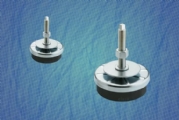 Add My Company
Add My Company
Sign In
WHITE PAPER SELECTION CRITERIA AND GUIDANCE NOTES FOR VIBRATION-DAMPING LEVELLING ELEMENTS
07-06-2010

Over recent years, there has been a steady improvement in performance of industrial machines leading to great improvements in both working speed and precision. This has stemmed from improved design and better quality of manufacture of the machines themselves – nonetheless they still operate by means of moving parts and this creates vibration. These moving bodies or non-balanced vibrating masses create vibrations or shocks which can cause malfunction and reduction of the machine lifespan and/or that of adjacent equipment. Where contact with personnel is involved then there is also significant concern for the operator – this is covered generally by the European directive about safety and healthy working with reference to noise and vibrations. Specifically mechanical vibration safety regulations for workers, in compliance with European directive 2004/44/CE 25 June 2002, prescribes the evaluation and the location of the health risks of workers exposed to mechanical vibration.
At Elesa we recognise two classes of isolation from unwanted vibration:
Active Isolation: to isolate and reduce the propagation of the vibration produced by the system.
Passive Isolation: to isolate and protect the system (for example measurement instruments) by vibrations coming from external sources.
Vibration characteristics
Frequency: measured in revolutions per minute [RPM] or cycles per second [Hz] is the number of oscillations or cycles done in a time unit. The frequency is a function of the mass and the rigidness of the element in subject.
Oscillation amplitude: with reference to the oscillation axis this is the maximum movement of the mass. The oscillation amplitude is a function of the energy received by the oscillating mass, higher frequency means an oscillation amplitude reduction.
Disturbing frequency: the frequency of the disturbing vibration produced by an on-duty machine. In general, it coincides with the number of rotations of the engine [RPM] or [Hz].
Natural frequency: when there are no external disturbances applied on the mass, the natural frequency is the vibration frequency of the system which is supported by the vibration-damping levelling elements [RPM] or [Hz].
The system can be classified by analyzing the ratio between disturbing frequency and natural frequency:
- Ratio < 1, the system is rigid, a result opposite to that required.
- Ratio between 1 e √2, resonance area, dangerous and uncontrolled evolution.
- Ratio > √2, isolation of the disturbing frequency.
Rigidness: that is to say the load that is applied to the vibration-damping element produces a deflection of 1mm [N/mm].
Isolation: the reduction degree of the energy due to the disturbing frequency [%].
Choosing the vibration damping element
1) Basic data required for correct choice of a vibration-damping element are:
- disturbing frequency, which is the frequency of the disturbing vibration produced by a machine when it is on duty. In general, it coincides with the number of rotations of the engine [rpm]
- the static load applied to every single vibration-damping element [N]
- the isolation degree required [%]
- damping disk deflection value [mm] under a given load
- the stiffness, which is the load that produces a deflection of 1mm [N/mm] when it is applied to the vibration-damping element.
The data sheets of the ELESA catalogue refer to LW.A - Vibration-damping levelling elements and DVA. - Vibration-damping elements, contain all the information needed for the choice of the elements matching the specific working conditions.
2) How to choose the vibration-damping element:
- with reference to the nomograph (graphic 1), intersect the disturbing frequency value with the isolation degree required (each isolation degree corresponds to a line on the nomograph) and define the deflection (static deflection mm)
- to obtain the required stiffness of the vibration-damping element, divide the load applied onto the vibra
For more information on WHITE PAPER SELECTION CRITERIA AND GUIDANCE NOTES FOR VIBRATION-DAMPING LEVELLING ELEMENTS talk to Elesa (UK) Ltd
Enquire Now
List your company on FindTheNeedle.

